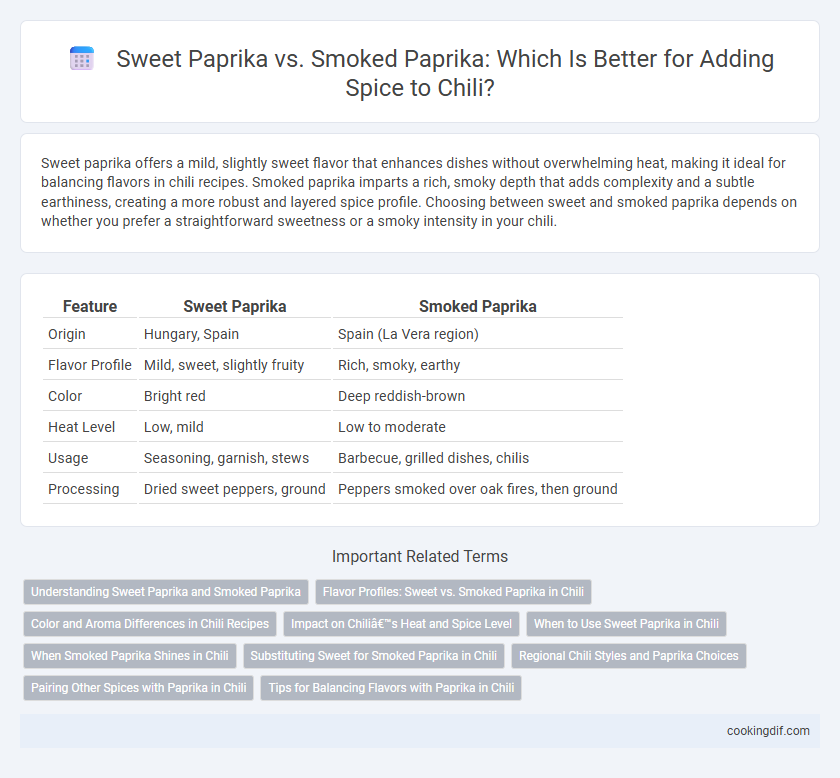Sweet paprika offers a mild, slightly sweet flavor that enhances dishes without overwhelming heat, making it ideal for balancing flavors in chili recipes. Smoked paprika imparts a rich, smoky depth that adds complexity and a subtle earthiness, creating a more robust and layered spice profile. Choosing between sweet and smoked paprika depends on whether you prefer a straightforward sweetness or a smoky intensity in your chili.
Table of Comparison
| Feature | Sweet Paprika | Smoked Paprika |
|---|---|---|
| Origin | Hungary, Spain | Spain (La Vera region) |
| Flavor Profile | Mild, sweet, slightly fruity | Rich, smoky, earthy |
| Color | Bright red | Deep reddish-brown |
| Heat Level | Low, mild | Low to moderate |
| Usage | Seasoning, garnish, stews | Barbecue, grilled dishes, chilis |
| Processing | Dried sweet peppers, ground | Peppers smoked over oak fires, then ground |
Understanding Sweet Paprika and Smoked Paprika
Sweet paprika, made from dried sweet red peppers, offers a mild, slightly sweet flavor ideal for enhancing dishes without overpowering them, commonly used in Hungarian and Spanish cuisines. Smoked paprika, derived from peppers dried over wood fires, provides a rich, smoky, and earthy taste, adding depth and complexity to meals like chili, stews, and barbecue recipes. Understanding the difference in flavor profiles and cooking applications helps in choosing the right paprika to balance spice levels and aroma in diverse chili preparations.
Flavor Profiles: Sweet vs. Smoked Paprika in Chili
Sweet paprika offers a mild, slightly fruity flavor that enhances chili with subtle warmth and vibrant color without overpowering other ingredients. Smoked paprika provides a deeper, smoky taste that adds complexity and a rich, earthy dimension, intensifying the chili's overall flavor profile. Choosing between sweet and smoked paprika depends on whether a bright, sweet undertone or a bold, smoky character is desired in the chili dish.
Color and Aroma Differences in Chili Recipes
Sweet paprika offers a bright red hue and a mild, slightly sweet aroma that enhances the color and flavor of chili without overpowering other spices. Smoked paprika provides a deeper, darker red color and imparts a rich, smoky aroma that adds complexity and warmth to chili recipes. Choosing between sweet and smoked paprika depends on whether a dish benefits more from vibrant color and gentle sweetness or intense smokiness and depth.
Impact on Chili’s Heat and Spice Level
Sweet paprika has a mild, slightly sweet flavor with minimal heat, making it ideal for adding color and subtle sweetness to chili without increasing spiciness. Smoked paprika brings a rich, smoky flavor and can range from mild to moderately hot, subtly enhancing the chili's heat and depth. Choosing between the two depends on whether the desired chili profile emphasizes smoky warmth or a gentle, sweet spice.
When to Use Sweet Paprika in Chili
Sweet paprika enhances chili with a mild, slightly sweet flavor that complements tomatoes and beans without overpowering other ingredients. Use sweet paprika when you want to add a vibrant red color and subtle depth without introducing smoky or bitter notes. It works best in classic chili recipes where a balanced, smooth spice profile is desired.
When Smoked Paprika Shines in Chili
Smoked paprika shines in chili when you want to add a deep, smoky flavor that complements the rich, spicy heat of the peppers without overpowering them. Its distinctive aroma enhances slow-cooked chili recipes, infusing the dish with a subtle complexity that sweet paprika lacks. Using smoked paprika in classic beef or bean chili elevates the overall taste by introducing savory, smoky undertones that balance the chili's natural acidity and spice.
Substituting Sweet for Smoked Paprika in Chili
Sweet paprika offers a mild, slightly sweet flavor that enhances chili without overpowering other spices. When substituting sweet paprika for smoked paprika, the characteristic smoky depth is lost, so consider adding a small amount of smoked salt or chipotle powder to mimic that complexity. For a balanced chili, adjusting seasoning with cumin and chili powder can help compensate for the missing smoky notes.
Regional Chili Styles and Paprika Choices
Sweet paprika, derived from milder red peppers, is often favored in Hungarian and Spanish chili styles for its subtle sweetness and vibrant color, enhancing dishes without overpowering heat. Smoked paprika, integral to Spanish and Southwestern American chili recipes, introduces a deep, smoky flavor from peppers dried over wood fires, complementing the rich, smoky undertones common in regional chili preparations. The choice between sweet and smoked paprika significantly influences the chili's flavor profile, reflecting local traditions and ingredient availability in various chili-producing regions.
Pairing Other Spices with Paprika in Chili
Sweet paprika offers a mild, slightly sweet flavor that pairs well with cumin, garlic powder, and oregano to enhance the warm, earthy profile of chili. Smoked paprika provides a rich, smoky depth that complements chipotle powder, chili powder, and black pepper, intensifying the chili's bold, smoky character. Using both sweet and smoked paprika together allows for a balanced spice blend, creating a layered and complex chili seasoning.
Tips for Balancing Flavors with Paprika in Chili
Sweet paprika provides a mild, slightly sweet flavor that enhances chili without overpowering the other spices, while smoked paprika adds a rich, smoky depth ideal for robust, hearty chili recipes. Balancing flavors with paprika involves starting with small amounts and adjusting to taste, ensuring the paprika complements rather than dominates the chili's complex aromatic profile. Combining both types can create a nuanced flavor profile, where sweet paprika brightens the dish and smoked paprika adds complexity, perfect for layered chili seasoning.
Sweet paprika vs smoked paprika for spice Infographic

 cookingdif.com
cookingdif.com